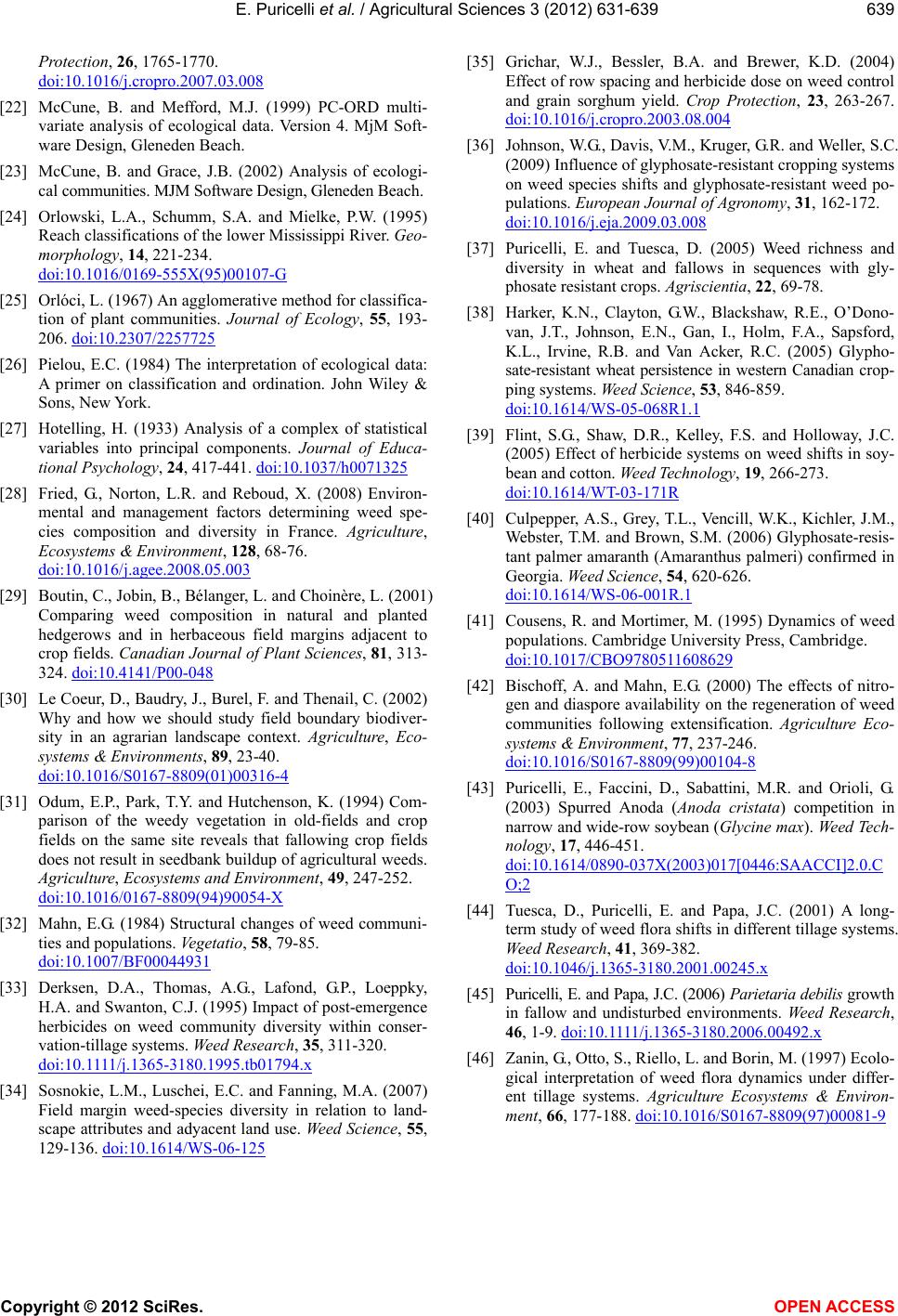
E. Puricelli et al. / Agricultural Sciences 3 (2012) 631-6 39
Copyright © 2012 SciRes. OPEN ACCES S
639
Protection, 26, 1765-1770.
doi:10.1016/j.cropro.2007.03.008
[22] McCune, B. and Mefford, M.J. (1999) PC-ORD multi-
variate analysis of ecological data. Version 4. MjM Soft-
ware Design, Gleneden Beach.
[23] McCune, B. and Grace, J.B. (2002) Analysis of ecologi-
cal communities. MJM Software Design, Gleneden Beach.
[24] Orlowski, L.A., Schumm, S.A. and Mielke, P.W. (1995)
Reach classifications of the lower Mississippi River. Geo-
morphology, 14, 221-234.
doi:10.1016/0169-555X(95)00107-G
[25] Orlóci, L. (1967) An agglomerative method for classifica-
tion of plant communities. Journal of Ecology, 55, 193-
206. doi:10.2307/2257725
[26] Pielou, E.C. (1984) The interpretation of ecological data:
A primer on classification and ordination. John Wiley &
Sons, New York.
[27] Hotelling, H. (1933) Analysis of a complex of statistical
variables into principal components. Journal of Educa-
tional Psychology, 24, 417-441. doi:10.1037/h0071325
[28] Fried, G., Norton, L.R. and Reboud, X. (2008) Environ-
mental and management factors determining weed spe-
cies composition and diversity in France. Agriculture,
Ecosystems & Environment, 128, 68-76.
doi:10.1016/j.agee.2008.05.003
[29] Boutin, C., Jobin, B., Bélanger, L. and Choinère, L. (2001)
Comparing weed composition in natural and planted
hedgerows and in herbaceous field margins adjacent to
crop fields. Canadian Journal of Plant Sciences, 81, 313-
324. doi:10.4141/P00-048
[30] Le Coeur, D., Baudry, J., Burel, F. and Thenail, C. (2002)
Why and how we should study field boundary biodiver-
sity in an agrarian landscape context. Agriculture, Eco-
systems & Environme nts, 89, 23-40.
doi:10.1016/S0167-8809(01)00316-4
[31] Odum, E.P., Park, T.Y. and Hutchenson, K. (1994) Com-
parison of the weedy vegetation in old-fields and crop
fields on the same site reveals that fallowing crop fields
does not result in seedbank buildup of agricultural weeds.
Agriculture, Ecosystems and Environment, 49, 247-252.
doi:10.1016/0167-8809(94)90054-X
[32] Mahn, E.G. (1984) Structural changes of weed communi-
ties and populations. Vegetatio, 58, 79-85.
doi:10.1007/BF00044931
[33] Derksen, D.A., Thomas, A.G., Lafond, G.P., Loeppky,
H.A. and Swanton, C.J. (1995) Impact of post-emergence
herbicides on weed community diversity within conser-
vation-tillage systems. Weed Research, 35, 311-320.
doi:10.1111/j.1365-3180.1995.tb01794.x
[34] Sosnokie, L.M., Luschei, E.C. and Fanning, M.A. (2007)
Field margin weed-species diversity in relation to land-
scape attributes and adyacent land use. Weed Science, 55,
129-136. doi:10.1614/WS-06-125
[35] Grichar, W.J., Bessler, B.A. and Brewer, K.D. (2004)
Effect of row spacing and herbicide dose on weed control
and grain sorghum yield. Crop Protection, 23, 263-267.
doi:10.1016/j.cropro.2003.08.004
[36] Johnson, W.G., Davis, V.M., Kruger, G.R. and Weller, S.C.
(2009) Influence of glyphosate-resistant cropping systems
on weed species shifts and glyphosate-resistant weed po-
pulations. European Journal of Agronomy, 31, 162-172.
doi:10.1016/j.eja.2009.03.008
[37] Puricelli, E. and Tuesca, D. (2005) Weed richness and
diversity in wheat and fallows in sequences with gly-
phosate resistant crops. Agriscientia, 22, 69-78.
[38] Harker, K.N., Clayton, G.W., Blackshaw, R.E., O’Dono-
van, J.T., Johnson, E.N., Gan, I., Holm, F.A., Sapsford,
K.L., Irvine, R.B. and Van Acker, R.C. (2005) Glypho-
sate-resistant wheat persistence in western Canadian crop-
ping systems. Weed Science, 53, 846-859.
doi:10.1614/WS-05-068R1.1
[39] Flint, S.G., Shaw, D.R., Kelley, F.S. and Holloway, J.C.
(2005) Effect of herbicide systems on weed shifts in soy-
bean and cotton. Weed Te chnolog y, 19, 266-273.
doi:10.1614/WT-03-171R
[40] Culpepper, A.S., Grey, T.L., Vencill, W.K., Kichler, J.M.,
Webster, T.M. and Brown, S.M. (2006) Glyphosate-resis-
tant palmer amaranth (Amaranthus palmeri) confirmed in
Georgia. Weed Sci ence, 54, 620-626.
doi:10.1614/WS-06-001R.1
[41] Cousens, R. and Mortimer, M. (1995) Dynamics of weed
populations. Cambridge University Press, Cambridge.
doi:10.1017/CBO9780511608629
[42] Bischoff, A. and Mahn, E.G. (2000) The effects of nitro-
gen and diaspore availability on the regeneration of weed
communities following extensification. Agriculture Eco-
systems & Environment, 77, 237-246.
doi:10.1016/S0167-8809(99)00104-8
[43] Puricelli, E., Faccini, D., Sabattini, M.R. and Orioli, G.
(2003) Spurred Anoda (Anoda cristata) competition in
narrow and wide-row soybean (Glycine max). Weed Tech-
nology, 17, 446-451.
doi:10.1614/0890-037X(2003)017[0446:SAACCI]2.0.C
O;2
[44] Tuesca, D., Puricelli, E. and Papa, J.C. (2001) A long-
term study of weed flora shifts in different tillage systems.
Weed Research, 41, 369-382.
doi:10.1046/j.1365-3180.2001.00245.x
[45] Puricelli, E. and Papa, J.C. (2006) Parieta ria debilis growth
in fallow and undisturbed environments. Weed Research,
46, 1-9. doi:10.1111/j.1365-3180.2006.00492.x
[46] Zanin, G., Otto, S., Riello, L. and Borin, M. (1997) Ecolo-
gical interpretation of weed flora dynamics under differ-
ent tillage systems. Agriculture Ecosystems & Environ-
ment, 66, 177-188. doi:10.1016/S0167-8809(97)00081-9